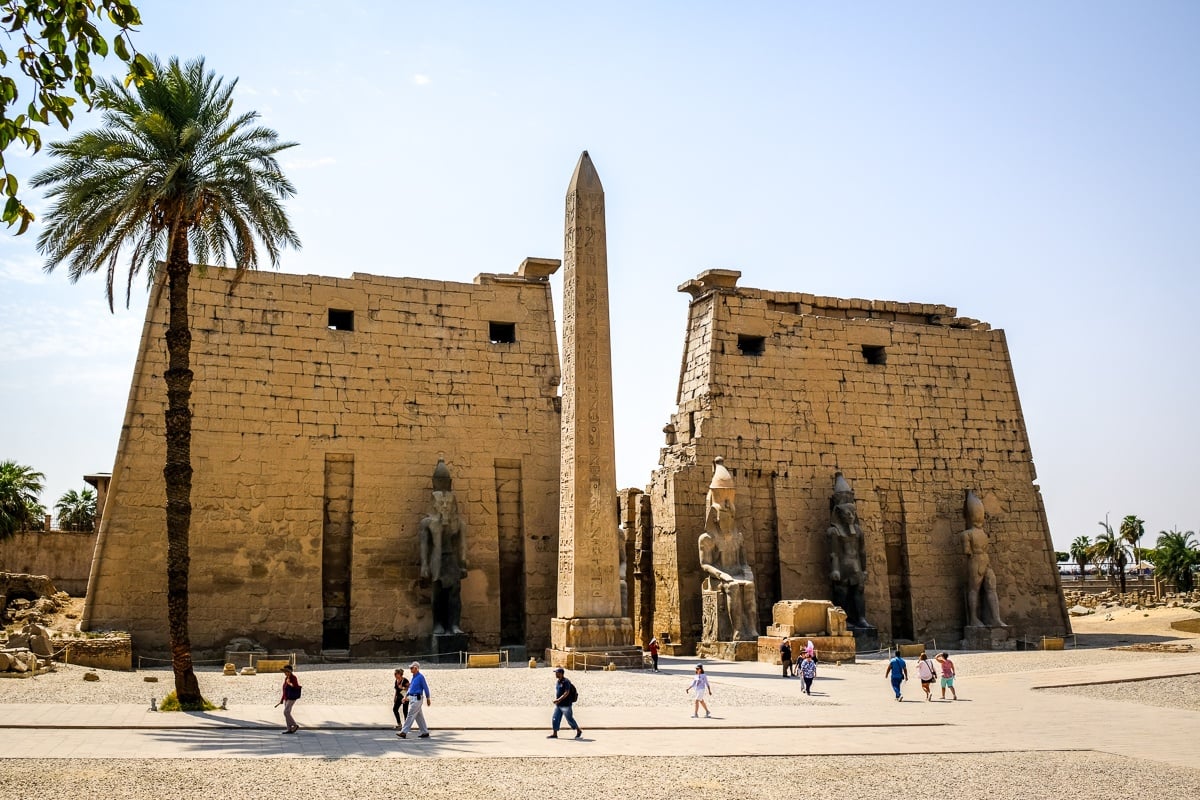Summary
Luxor Temple is one of the most famous and easily accessible Egyptian temple ruins in the Luxor area of Egypt. Luxor was formerly the ancient capital of Egypt, making the city rich in Egyptian temples, tombs, and artifacts from historical times. Therefore, don’t miss this gem of the Nile during your trip through Egypt! This travel guide will explain how to get there and everything you need to know before you explore!
Where To Stay




History Of Luxor Temple
The history of Luxor Temple dates back to 1400 BC, when what is now Luxor city served as the site of ancient Egypt’s city of Thebes. Thebes, being the capital of the Egyptian kingdom for hundreds of years, hosted a number of famous temples constructed along both sides of the Nile River.
Luxor Temple was primarily built by pharaohs Amenhotep III and Ramesses II, with contributions from Tutankhamun, Alexander the Great, and the Romans. During Roman times, parts of the temple were converted into a church, leading to its gradual burial under sand.
Over the years, medieval Muslim settlers constructed homes and a mosque atop the temple, obscuring it from view. However, massive excavation and restoration efforts by French Egyptologists began in 1885 and continued intermittently until the 1960s. Recently, a renovated avenue of sphinxes was unveiled in 2021.
Today, Luxor Temple is surprisingly well-preserved despite its age and is recognized as a UNESCO World Heritage site.






Visiting Luxor Temple
Like the other ancient sites in Egypt, Luxor Temple exudes magic, making it enjoyable for both history buffs and casual travelers. Most visitors can explore the entire temple in about 60 minutes, depending on their pace and how much time they take to absorb the surroundings.
It’s advisable to visit early in the morning to avoid the heat and crowds or later in the evening when the sandstone walls are illuminated by the sunset. After dark, the temple is lit up, presenting an even more mysterious ambiance.


Best Things To See & Do
Key features to explore at Luxor Temple include:
- The avenue of sphinxes at the front entrance.
- The pharaoh statues and main pylons (walls) adorned with carvings depicting Egyptian chariots in battle.
- The inner courtyard lined with dozens of standing stone columns.
One standout highlight is the impressive 25-meter (80-foot) obelisk at the temple’s entrance, known for its exceptional animal hieroglyphs. Although there were originally two obelisks, the other now resides in Paris.


Hours & Entrance Fees
- Hours: 6 AM – 10 PM
- Entrance Fee:* 160 EGP
- Students: 80 EGP with ID
- Photos: Free**
*Purchasing the Luxor Pass includes access to this temple.
**There is no additional charge for taking photos with a phone or DSLR at Luxor Temple.


How To Get There
Luxor Temple is situated on the east bank of the Nile River in Luxor, Egypt. Direct flights from Cairo International Airport (CAI) to Luxor airport (LXR) take approximately one hour and cost around $90 USD or less. Alternatively, a day train from Cairo takes about 9 hours and costs roughly $10. You can search for flights to Luxor on Skyscanner.
Once in Luxor city, many hotels are within walking distance of the temple. If you are on the west bank, a cost-effective public ferry crosses the Nile and stops near the temple.
Be prepared for persistent touts along the way; this is common in Luxor!
Best Luxor Temple Tours
If you prefer a guided experience, various vetted tour companies offer comprehensive tours to the Luxor temples. For example, here is a Luxor day tour package covering the West Bank or East Bank, including renowned sites like the Colossi of Memnon, Luxor Temple, Valley of the Kings/Queens, and Karnak Temple.
This company has been used for numerous tours globally, and they come highly recommended!
More Egypt Travel Tips
Thank you for reading! I trust these travel tips for visiting Luxor Temple in Egypt have been helpful.
Make sure to explore the Egypt Travel Guide and the complete list of the best things to do in Egypt!





